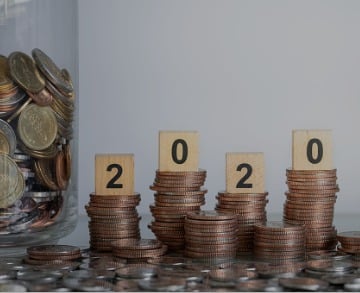In January 2020, we highlighted our reasoning as to why we believed the stock market was overvalued. For starters, the prior year had just delivered double-digit stock market returns alongside a profits recession.
This feat had only ever happened twice before, both times emerging from a recession (2001 & 2008). We were also witnessing an extreme disconnect between the stock market and the economy (a record low correlation of 2%). However, a few short months later, a global pandemic very few saw coming, flipped the world upside down.
Without question, the measures taken in the last six months have been unprecedented. Will the second half of 2020 be as eventful as the first half? Time will tell.
Contrary to all talk about how the pandemic has driven behavioural change, longer-term trends remain. The one observed change: these trends have now been pulled forward (in some cases, by up to 3-5 years). More specifically, COVID-19 has accelerated the demand for medical technology, surveillance, and automation.
With the world beginning to re-open, we felt it imperative to revisit our key topics from OUTLOOK 2020 and provide insight into our future expectations.

In our January 2020 article, What Can We Expect in The Year, and Decade Ahead? we highlighted three key areas that would have the most profound impact over the next ten years:
- Globalization
- Connectivity
- Demographics
HAS GLOBALIZATION PEAKED?
Globalization is collaboration and is facing more challenges today than it has in recent memory. Years of ongoing trade wars between the world's two largest nations have provided much of the fuel for de-globalization. Introduce a highly contagious virus and border lockdowns, and you've got your accelerant. Buy local is a great concept, but it comes at a cost. Inflation is coming. Maybe not today. Maybe not tomorrow. But all the necessary ingredients are present.
CONNECTIVITY TO THE MAX!
The intangible value of 5G is difficult for many to comprehend. Every nation needs it, so instead, focus on the lucrative opportunity for those who develop it first. The result has been a US/China trade war, one that looks more like a tech war.
All Governments and Corporations are sparing no expense to build out 5G infrastructures. Being early stages, we are investing in the picks-and-shovels underpinning the technology – think software, hardware and sensors – a massive area of growth for the next decade.
DEMOGRAPHICS: THE DOMINO EFFECT
2018 was the first time in history where the number of people older than 64 surpassed the number of children under 5.
Regardless of the economic, market or societal environment, our ageing world relentlessly forges ahead. Recently, vulnerabilities within global healthcare systems have been exposed by the COVID-19 pandemic. This has led to a surge in medical spending. We see accelerating investment in med-tech as a significant opportunity for years to come.
UPDATES SINCE OUTLOOK
CONCENTRATION RISK
The largest five companies in the S&P 500 now account for roughly 22% of the market value of the entire index (it was ~18% six months ago). In response to the pandemic, shutting down the world has led to the most significant wealth transfer in history between small and large businesses (i.e. The Amazon Effect). Deemed “non-essential,” many small businesses were forced to close their doors. The unfortunate reality is that many of these companies will never recover, creating further concentration risk as the big, international monopolies step in to fill the void.
STOCK BUYBACKS & INSIDER SELLING
Ending 2019, buybacks and insider selling were hitting record highs. We highlighted this at OUTLOOK to help illustrate the artificiality of the stock market.
But, what goes up… you know the rest. Companies who have tapped into COVID stimulus programs have been banned from buying back their stock – it is not an exaggeration to say that buybacks have become politically incorrect. Additionally, the Federal Reserve recently ordered the largest 33 banks in the U.S. to suspend their buyback programs. Year-to-date announced buybacks for S&P 500 companies are tracking more than 50% below prior-year levels, and actual buybacks are on pace for a record low. Going forward, we expect only cash-heavy, high-profit companies to repurchases company shares. Financial engineering of the past decade is coming to an end a bit quicker than expected.
modern monetary THEORY (MMT)
No one could have predicted the magnitude of global stimulus year-to-date in response to the pandemic (approximately $9 trillion). That is trillion, with a ‘t,’ comprised of twelve zeros! With debt levels soaring uncontrollably, how will this debt ever be repaid? Are taxes heading higher? Most likely. Or, perhaps governments will try to inflate their way out of debt by printing more money?
CURRENCY MATTERS
Sanctions and tariffs are accelerating the decline of the SWIFT system and reserve currency status of the US dollar. MMT has significant consequences, including currency devaluation and rising inflation.
EXPECTATIONS GOING FORWARD
We are in a Bear Market (read Anatomy of a Bear Market) and expect enhanced volatility to be the new status quo. The S&P has rebounded ~45% since its lows in late March (still down ~7% from its February high). This quick snapback highlights a deepening divide between the stock market and the economy (which now faces its biggest challenge since the Great Depression). At only the halfway point of the year, over 30% of the companies in the S&P 500 index have suspended their buyback programs or cut their dividends.
Our long-term themes remain intact. Active management and balancing risk remain essential, and market alternatives will continue to create a buffer for portfolios. We believe that exposure to gold, inflation-protected bonds (RRB), and multiple currencies (including the RMB) is warranted. Although Gold and gold producers have been the best performing assets now two-years running, we believe that we are in the early innings of this hard asset cycle.
Now is not the time to chase – volatility will create opportunities.
SOME QUESTIONS WE ARE STILL PONDERING THAT COULD SET THE STAGE FOR NEXT YEAR:
- How will countries pay back the debt they are taking on for emergency stimulus? Or does it even matter?
- Will MMT allow printing presses to run freely? And, will infrastructure be the biggest beneficiary?
- How fast will the economy recover from the Pandemic lock-down? Will 90% consumption be good enough?
